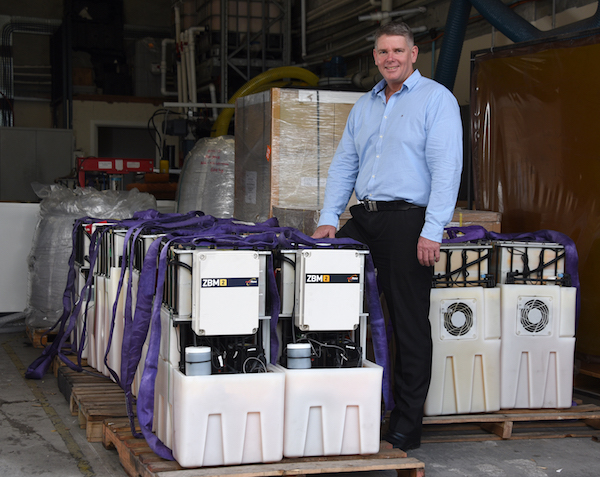 Redflow CEO Richard Aird with ZBM2 batteriesAustralian battery company Redflow Limited has successfully started manufacturing core components for its zinc-bromine flow batteries at its new production facility in Thailand.
Redflow CEO Richard Aird with ZBM2 batteriesAustralian battery company Redflow Limited has successfully started manufacturing core components for its zinc-bromine flow batteries at its new production facility in Thailand.
During the past week, Redflow began producing electrode inserts made of HDPE (High-Density Polyethylene) plastic on the production line at the factory in the Hemaraj industrial estate, south-east of Bangkok. The electrode inserts - produced from custom-made highly conductive plastic- use a bipolar design to enable a zinc-plating reaction on one side and a bromine reaction on the other.
Redflow CEO Richard Aird said production of the first components was going according to plan, as outlined last month at the company’s Annual General Meeting in Brisbane. “We remain on track to produce full battery stacks from our Thai factory next month,” he said.
“These electrode inserts are critical components in our zinc-bromine flow battery stack, enabling the plating of zinc on one surface of the insert while the battery is charging. This component contains a significant amount of Redflow IP (Intellectual Property), so we’re making sure these inserts are produced to our standard before progressively qualifying additional battery components.”
For media assistance, please call John Harris on +61 8 8431 4000 or email john@impress.com.au.
About Redflow www.redflow.com
Redflow’s unique zinc-bromine flow batteries are designed for stationary energy storage applications ranging from its ZCell residential battery to its scalable ZBM2 batteries for industrial, commercial, telecommunications and grid-scale deployment. Redflow Limited, a publicly-listed company (ASX: RFX), produces high energy density batteries that are sold, installed and maintained by an international network of system integrators. Redflow batteries offer unique advantages including 100 per cent depth of discharge, tolerance of ambient temperatures as hot as 50 degrees Celsius and sustained energy storage of 10 kilowatt hours (kWh) throughout its operating life.
Related News
- Redflow welcomes safety-first fire rules for batteries Redflow CEO Simon HackettAustralian battery company Redflow Limited (ASX:RFX) has praised proposed new regulations that prioritise fire safety for the deployment of lithium-based b...
- Redflow joins International Zinc Association to drive initiative promoting zinc battery benefits Redflow MD & CEO Tim HarrisHighlights: IZA members represent 60 per cent of worldwide zinc production and 80 per cent of Western Hemisphere production IZA’s Zinc Batte...
- Soul Energy partners with Redflow for infrastructure rollouts Redflow Managing Director and CEO Tim HarrisAustralian energy storage company Redflow Limited (ASX: RFX) has secured preferred supplier status with Soul Energy to provide batteries...
- Redflow announces new CEO and COO Simon HackettRedflow Limited (ASX:RFX) on Friday announced senior management changes as the company prepares for the first deliveries of ZCell residential flow batteries in Austral...





